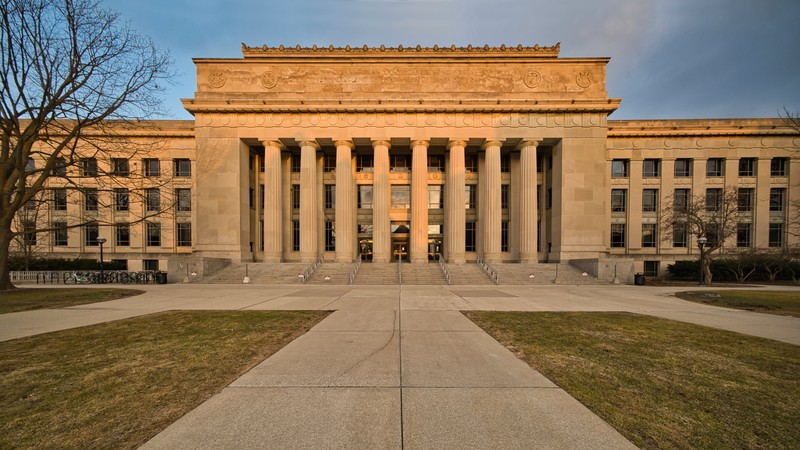Angell Hall and The Fishbowl
Introduction
Text-to-speech Audio
We are now standing in between the Angell Hall auditoriums, the location of the first teach-in in American history, and the Fishbowl, once the site of the humiliation of a Marine recruiter. Starting with President Eisenhower in the 1950s, the United States escalated its military involvement in Vietnam's Civil War to prevent the spread of communism in the region. In the early 1960s, the American public (and most likely, even students!) supported military action in Vietnam, like it had with US involvement in earlier wars. But students and other activists began to question this, leading to smaller protests in 1965 and eventually mass protests by the end of the decade.
Images
.jpg)

Backstory and Context
Text-to-speech Audio
On March 24, 1965, in the Angell Hall Auditoriums (over here) is where one of the most influential opposition reactions to the war took place. The first teach-in was where a group of U-M professors organized an opposition to the “moral, political, and military consequences” of the Vietnam War. These faculty originally wanted to strike, but after pressure from University administration, they decided instead to hold a teach-in that would educate people about the war and US involvement therein. It lasted through the night and was attended by about 3,000 people, who were encouraged to engage in debate, which is one of the most important points of a democracy. One of the big groups involved in this teach-in was the Students for a Democratic Society.
The events that occurred in these rooms inspired more than 50 similar teach-ins at universities around the world. As a result, President Johnson’s ability to shape public opinion about the Vietnam War—especially among young people–was greatly impacted.
During the War, college students could not be drafted into the military—they had what was called a student deferment. Since universities are full of young men and women, the US Military wanted to recruit volunteers, especially into the Army, Navy, and Marine Corps’ ROTC programs to become officers in their respective branches. Here, in the Fishbowl, students protested the military’s ROTC presence on campus in the late 1960s.
As the war escalated and the US faced more casualties, student demonstrations also escalated. For example, the Tet Offensive in 1968 where American forces suffered heavy losses at the hands of the North Vietnamese forces lined up with an increase in tension on campus. Unlike the early teach-ins, these protests became extreme and at times even violent, including an attempt by the Students for a Democratic Society to drag a recruiter against his will into the Fishbowl to publicly humiliate him.
Sources
Bentley Historical Library. “A Decade of Dissent: Student Protests at the University of Michigan in the 1960s” (online exhibit; archived via PDF). Bentley Historical Library. https://deepblue.lib.umich.edu/bitstream/handle/2027.42/111871/A%20Decade%20of%20Dissent%20Student%20Protests%20at%20the%20University%20of%20M%20-%202006_bhl-158bcafe.pdf?sequence=3&isAllowed=y
Brown, Obadiah, Maria Buczkowski, Chris Haughey, Matthew Lassiter, Andreea Matei, Kevin Trierweiler. Resistance and Revolution: The Anti-Vietnam War Movement at the University of Michigan, 1965-72 (online exhibit). https://michiganintheworld.history.lsa.umich.edu/antivietnamwar/
Gleen, Alan. “Teach-in + 50.” Michigan Today. March 16, 2015. https://michigantoday.umich.edu/2015/03/16/teach-in-50/
Roper, Camilla, and J. H. Evans. “North Hall: 1900-2014.” Naval ROTC, University of Michigan. https://navy.rotc.umich.edu/wp-content/uploads/2014/07/A-North-Hall-History.pdf
Tobin, James. “If North Hall could talk.” Michigan Today. August 19, 2014. https://michigantoday.umich.edu/2014/08/19/if-north-hall-could-talk/
